A tale of Tipu’s bird of fortune
Editor’s note: ‘The Tiger of Mysore’, Tipu Sultan was the proud owner of a bespoke gold bird, studded with gemstones, proudly perched atop his gilded throne. Called Huma, the mythical bird from the Zoroastrian tradition symbolised happiness and good fortune. Upon Tipu’s defeat by the British, their troops dismantled his throne and stole the figurine. Having changed hands many times over the years, it is now housed at Windsor Castle, England, as part of the Royal Collection.
This article originally appeared on the MAP Academy website. All images that appear with the MAP Academy articles are sourced from various collections around the world, and due image credits can be found on the original article on the MAP Academy website. The MAP Academy is a non-profit online educational platform committed to building equitable resources for the study of art histories from South Asia.
*****
A gold figurine densely studded with gemstones, the Huma bird ornament was crafted in the late eighteenth century, commissioned by Tipu Sultan (r. 1782–99), the ruler of the Deccan princely state of Mysore in southern India. It represents the Huma or Homa, a mythical bird from the Zoroastrian tradition that symbolises good fortune and happiness. The ornament was fixed on the canopy of Tipu’s intricately constructed, gilded throne at Seringapatam (now Srirangapatna), then capital of Mysore. It was stolen, along with other such ornaments, by British troops who dismantled the throne when Tipu was defeated in the Fourth Anglo-Mysore War in 1799. It is now housed in the Royal Collection of the United Kingdom, the largest private art collection in the world.
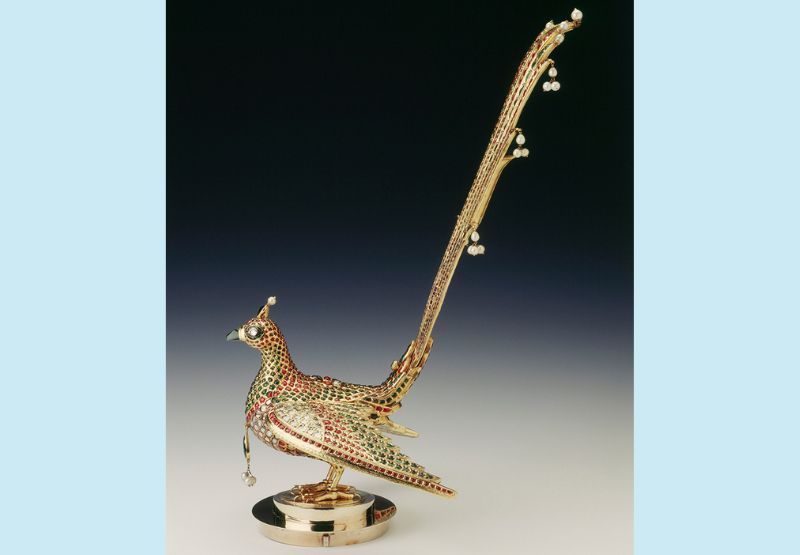 (This stunning bird now rests at Windsor Castle, England, at the Royal Collection Trust.)
(This stunning bird now rests at Windsor Castle, England, at the Royal Collection Trust.)
The figurine depicts the bird standing with its wings partially outstretched. It measures 28 centimetres from beak to tail, 20 centimetres across, and 42 centimetres tall — the long, nearly vertical tail of the bird accounts for most of its height. It is fixed on a round gold stand, a later addition to the object after it was taken from Seringapatam. The head and body of the ornament are studded all over with rubies, emeralds, and diamonds; the beak is made from a pointed emerald and the eyes are formed from two large diamonds surrounded by tiny emeralds. In the middle of its back are nine gemstones set in the form of a flower — a central ruby surrounded by a hessonite garnet, a blue sapphire, what is likely a yellow topaz, a tiger’s eye, an emerald, a diamond, a pearl and a coral.
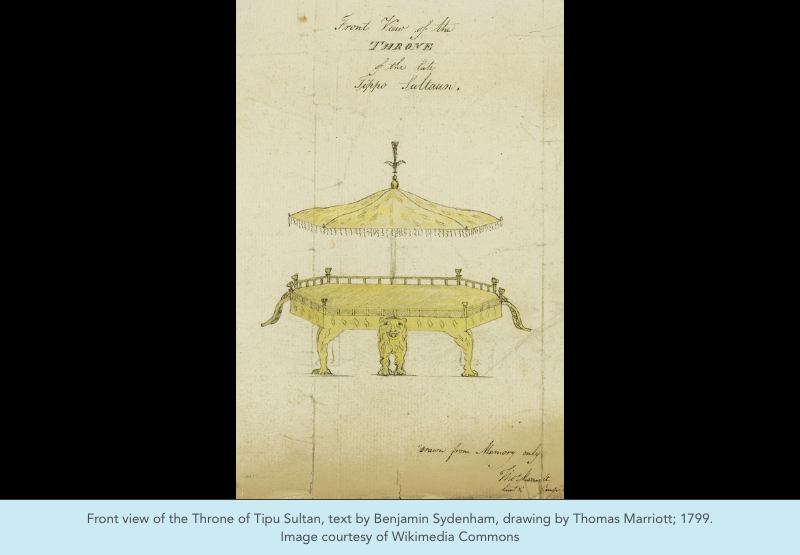 The tail comprises eleven plumes, slightly fanned out, with each ending in a curved, pointed tip — each of the five central plumes is pearl-tipped; each of the others has a cluster of three pearls hanging from the tip. The bird’s head has a crest formed by an inverted teardrop-shaped emerald topped with a pearl; a similar arrangement in a larger size hangs as a pendant from the front of its chest.
The tail comprises eleven plumes, slightly fanned out, with each ending in a curved, pointed tip — each of the five central plumes is pearl-tipped; each of the others has a cluster of three pearls hanging from the tip. The bird’s head has a crest formed by an inverted teardrop-shaped emerald topped with a pearl; a similar arrangement in a larger size hangs as a pendant from the front of its chest.
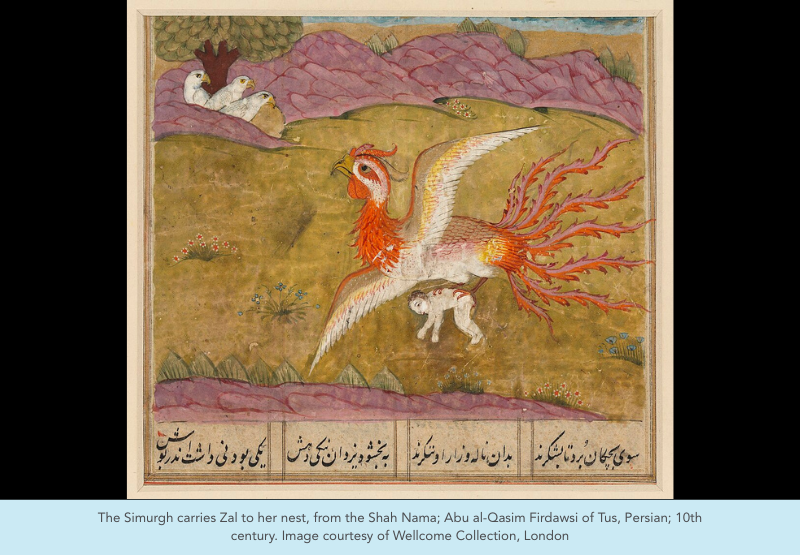 The image of the Huma bird has its roots in Zoroastrian mythology, originating in ancient Persia. The bird is said to be in eternal flight, never alighting on earth, and bestowing luck and happiness to whomever its shadow touches. It was also believed that the shadow of the bird conferred kingship on an individual and ensured imperial success. The Huma is often conflated with the Simurgh — another Zoroastrian mythical creature, which, according to some scholars, is an earlier version of the Huma in Persian mythology, art and literature. Often depicted with the head of a human or a dog, the claws of a lion, and an eagle’s wings, the Simurgh is said to periodically plunge into flames and emerge resurrected, similar to the Ancient Greek phoenix.
The image of the Huma bird has its roots in Zoroastrian mythology, originating in ancient Persia. The bird is said to be in eternal flight, never alighting on earth, and bestowing luck and happiness to whomever its shadow touches. It was also believed that the shadow of the bird conferred kingship on an individual and ensured imperial success. The Huma is often conflated with the Simurgh — another Zoroastrian mythical creature, which, according to some scholars, is an earlier version of the Huma in Persian mythology, art and literature. Often depicted with the head of a human or a dog, the claws of a lion, and an eagle’s wings, the Simurgh is said to periodically plunge into flames and emerge resurrected, similar to the Ancient Greek phoenix.
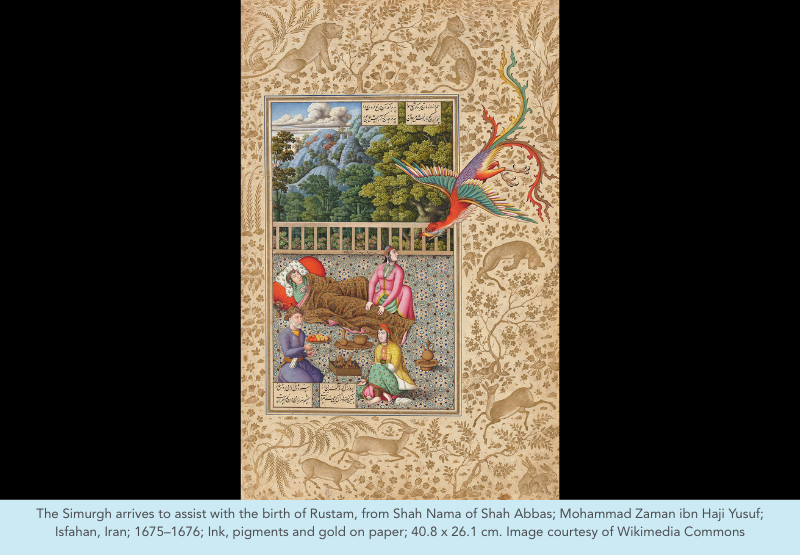 Zoroastrianism was the state religion of ancient Persia for more than a millennium, between 550 BCE and 651 CE; a large sculpture of the Huma or Simurgh has survived to this day at Persepolis, the capital of the Achaemenid empire (550–350 BCE). Despite the decline of Zoroastrianism after the spread of Islam in seventh-century CE Persia, some of its symbolism is retained in Sufism, which spread rapidly in South Asia after the tenth century CE.
Zoroastrianism was the state religion of ancient Persia for more than a millennium, between 550 BCE and 651 CE; a large sculpture of the Huma or Simurgh has survived to this day at Persepolis, the capital of the Achaemenid empire (550–350 BCE). Despite the decline of Zoroastrianism after the spread of Islam in seventh-century CE Persia, some of its symbolism is retained in Sufism, which spread rapidly in South Asia after the tenth century CE.
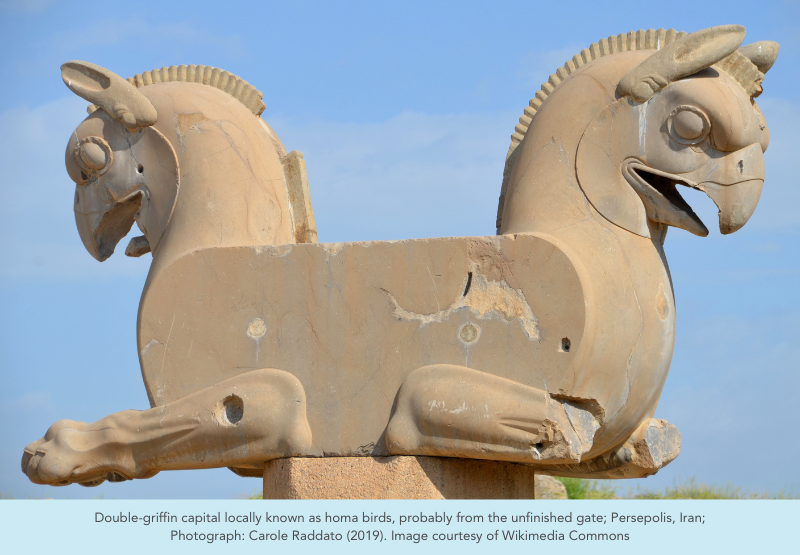 As a result, the Huma bird appears in artworks made in the courts of South Asian Islamicate dynasties as a symbol of royal power: in one seventeenth century Mughal manuscript painting, it appears on the cloth canopy above the emperor Shah Jahan’s throne; an eighteenth-century painting by Nainsukh of Guler shows Raja Balwant Singh of Jasrota wearing a kalghi, a feathered crest on his turban, featuring a plume of feathers said to be taken from the Huma bird.
As a result, the Huma bird appears in artworks made in the courts of South Asian Islamicate dynasties as a symbol of royal power: in one seventeenth century Mughal manuscript painting, it appears on the cloth canopy above the emperor Shah Jahan’s throne; an eighteenth-century painting by Nainsukh of Guler shows Raja Balwant Singh of Jasrota wearing a kalghi, a feathered crest on his turban, featuring a plume of feathers said to be taken from the Huma bird.
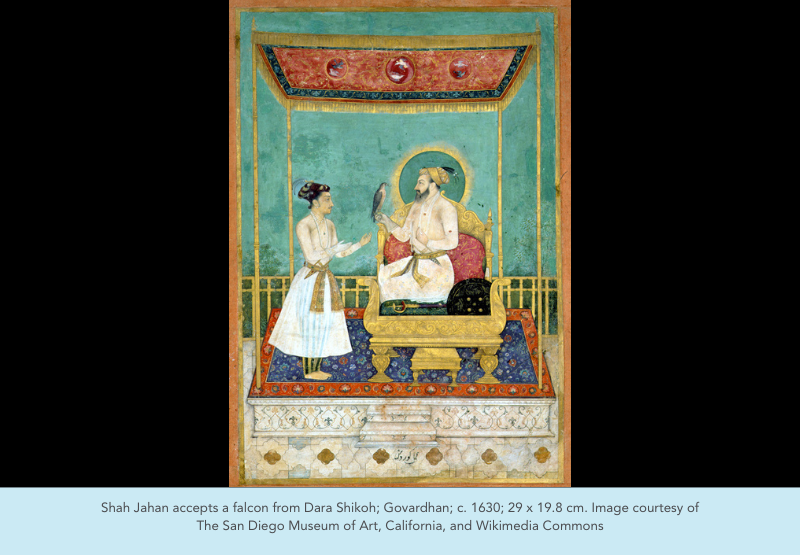 The nineteenth-century Indian poet Mirza Ghalib once remarked that he could only write of his despair in ink made from the auspicious shadow of the Huma bird. The motif of the resurrection of the Simurgh features in Sufi fables and poetry as a metaphor for the soul’s relationship with God or the Beloved. Given his extensively documented interest in Sufism, Tipu would have likely found merit in installing the ornate gold Huma bird over his throne, positioned so as to be directly over his head as he took his seat.
The nineteenth-century Indian poet Mirza Ghalib once remarked that he could only write of his despair in ink made from the auspicious shadow of the Huma bird. The motif of the resurrection of the Simurgh features in Sufi fables and poetry as a metaphor for the soul’s relationship with God or the Beloved. Given his extensively documented interest in Sufism, Tipu would have likely found merit in installing the ornate gold Huma bird over his throne, positioned so as to be directly over his head as he took his seat.
Scholars believe that Tipu never sat on the throne, however, being preoccupied with protecting the kingdom of Mysore from annexation by the British East India company — from 1767 to 1799, he fought consecutive wars with the British. The Fourth Anglo-Mysore War (1798–99) came to an end with his death and the siege of Seringapatam. The palace was captured and looted by British officers; Tipu’s elaborate throne was dismantled and the gold distributed amongst British soldiers. The Huma bird and other ornaments of the throne, which included two large and two small gold tiger figurines, were auctioned off for high sums that were still a fraction of their true value.
 Later, the incumbent Governor General Lord Wellesley recalled the auctioned items hoping to have the throne reassembled and presented to King George III of Britain as a gift from the officers of the British East India Company. The Huma bird ornament was reacquired by the officers and gifted to Queen Charlotte in 1800. As per the provenance and inventory record of the object, the ornament was passed on by Queen Charlotte to her daughters, who in turn left it to King George IV in 1818. At the time of writing, it is housed at Windsor Castle, England, as part of the Royal Collection.
Later, the incumbent Governor General Lord Wellesley recalled the auctioned items hoping to have the throne reassembled and presented to King George III of Britain as a gift from the officers of the British East India Company. The Huma bird ornament was reacquired by the officers and gifted to Queen Charlotte in 1800. As per the provenance and inventory record of the object, the ornament was passed on by Queen Charlotte to her daughters, who in turn left it to King George IV in 1818. At the time of writing, it is housed at Windsor Castle, England, as part of the Royal Collection.
Other valuable objects looted from the Seringapatam palace included a gold finial of a tiger’s head, also a part of Tipu’s throne, as well as his jewelled daggers and swords, armour and rare books from his library. In 2019, the Indian government formally objected to the auction of several items from Tipu’s palace at a UK auction house; however, the auction took place as scheduled.
Despite requests for repatriation from civilian groups, the UK government has periodically enacted temporary export bans on some of Tipu’s objects, based on the recommendation of the UK’s Reviewing Committee on the Export of Works of Art and Objects of Cultural Interest (RCEWA), which claims that the objects cannot be returned given their significance for Britain’s history. Whilst the bans are typically lifted if no UK buyer steps forward to bear the cost of the object, such measures draw attention to the larger issue of repatriation of several such stolen artefacts that remain housed in the Royal Collection.
*****
The MAP of Knowledge
Sign up for the MAP Academy's free online course, Modern & Contemporary Indian Art, authored by Dr Beth Citron and developed in partnership with Terrain.art. Through engaging videos, illustrated texts and interactive quizzes, the course introduces a range of artists such as Amrita Sher-Gil, Zarina Hashmi and Sudhir Patwardhan, and explores a trajectory of key figures, artworks and pivotal moments in modern history. Spanning the late-19th century to the present day, it also examines artistic responses to several shifting socio-political forces of the time.
This article has been written by the research and editorial team at the MAP Academy. Through its free knowledge resources—Encyclopedia of Art, Online Courses, and Stories—the MAP Academy encourages knowledge building and engagement with the region's visual arts. Follow them on Instagram to learn more about art histories from South Asia.

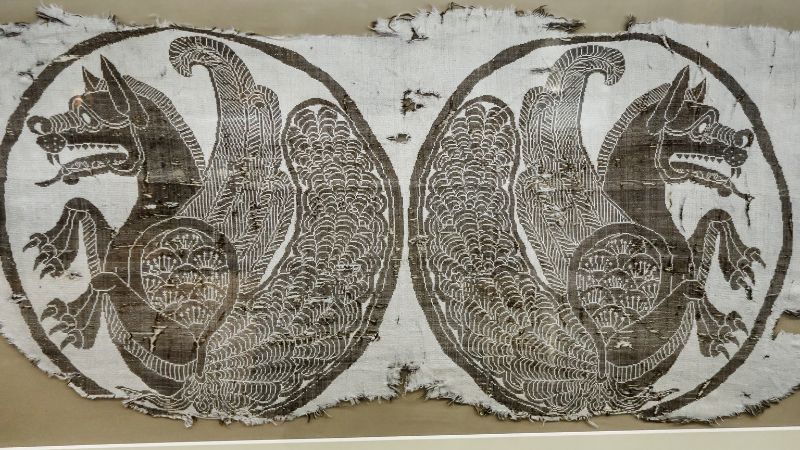
 souk picks
souk picks